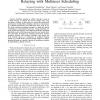511 search results - page 62 / 103 » Design Choices in the SHRIMP System: An Empirical Study |
DSS
2007
15 years 13 days ago
2007
The primary objective of a knowledge-based system (KBS) is to use stored knowledge to provide support for decision-making activities. Empirical studies identify improvements in de...
CAISE
2007
Springer
15 years 6 months ago
2007
Springer
Introducing process-aware information systems (PAIS) in enterprises is usually associated with high costs. It is therefore crucial to understand those factors that determine these ...
104
click to vote
IJCAI
2007
15 years 1 months ago
2007
Agents with partial observability need to share information to achieve decentralised coordination. However, in resource-constrained systems, indiscriminate communication can creat...
111
Voted
CISS
2007
IEEE
15 years 6 months ago
2007
IEEE
— Multihop relaying in cellular networks is seen as a viable strategy to address the need for higher data rates and better coverage. In this paper, we analyze the system-level pe...
92
Voted
CSCW
2000
ACM
15 years 4 months ago
2000
ACM
Environmental factors affecting shared spaces are typically designed to appeal to the broadest audiences they are expected to serve, ignoring the preferences of the people actuall...

